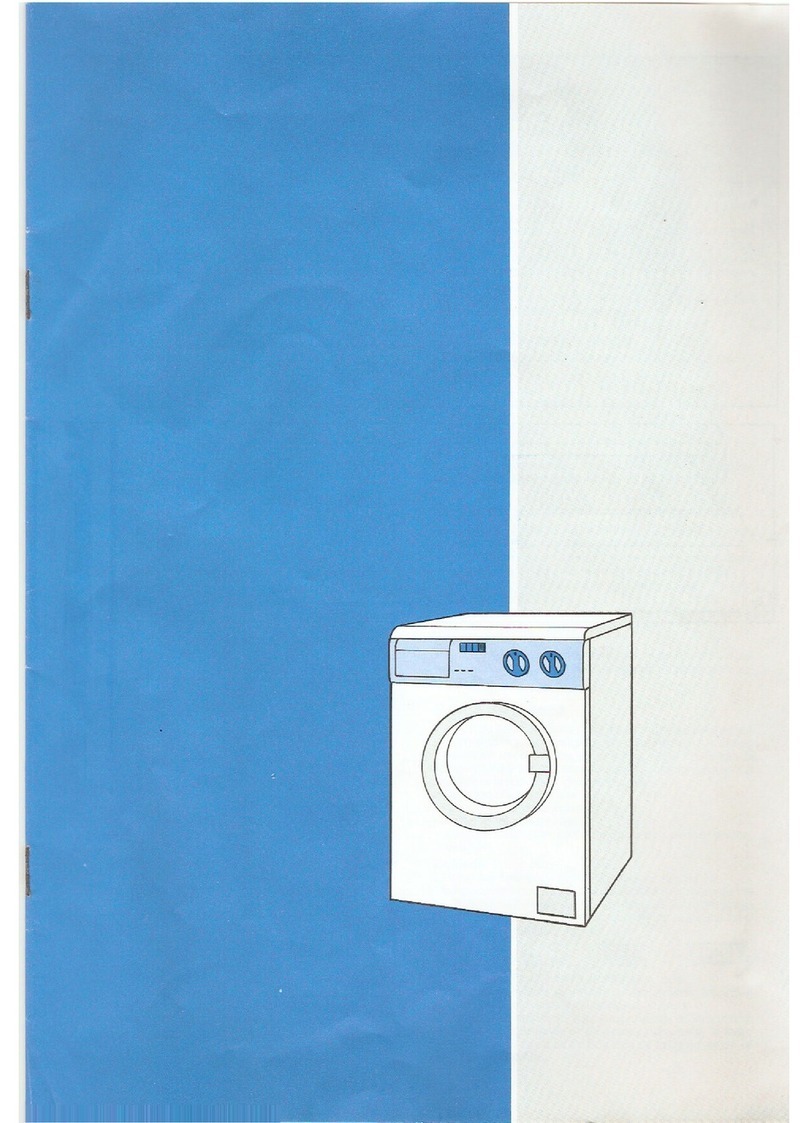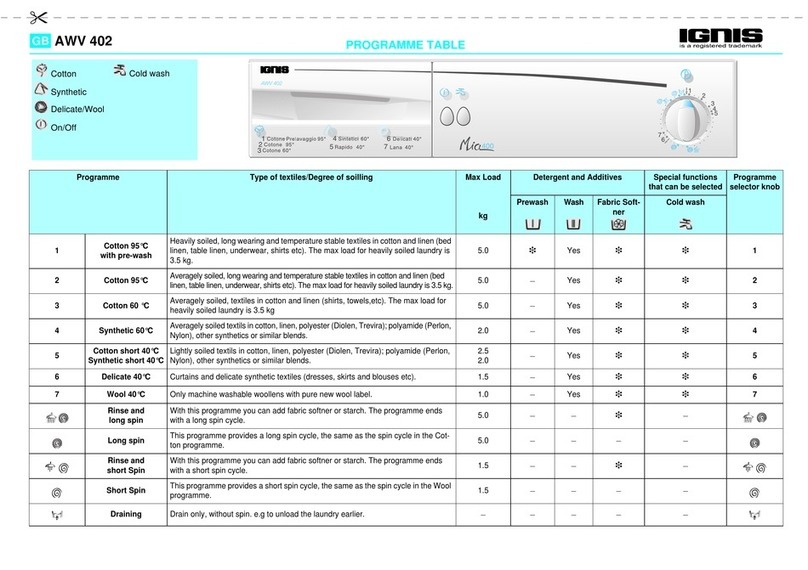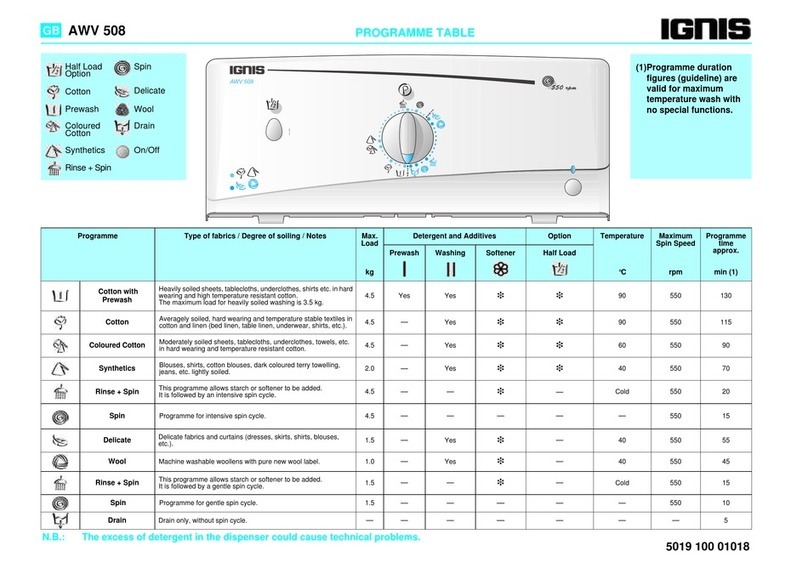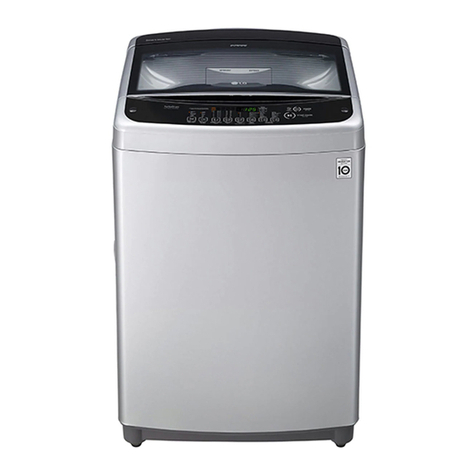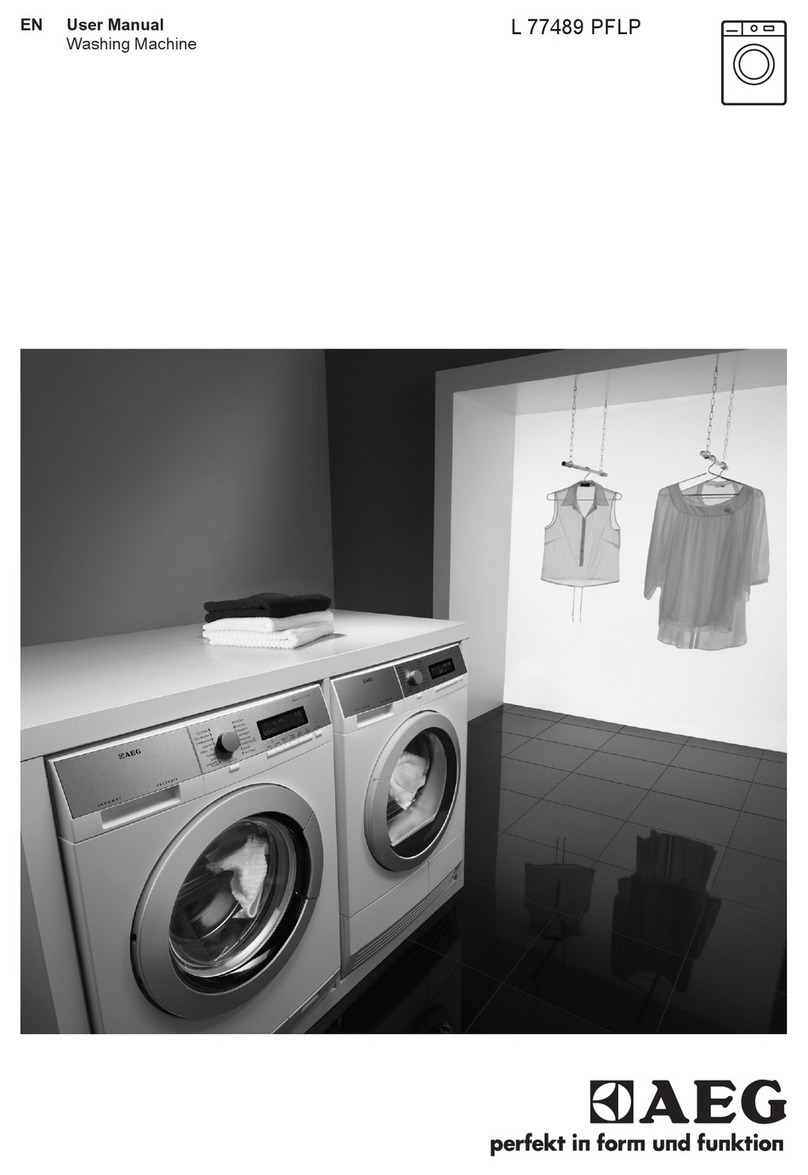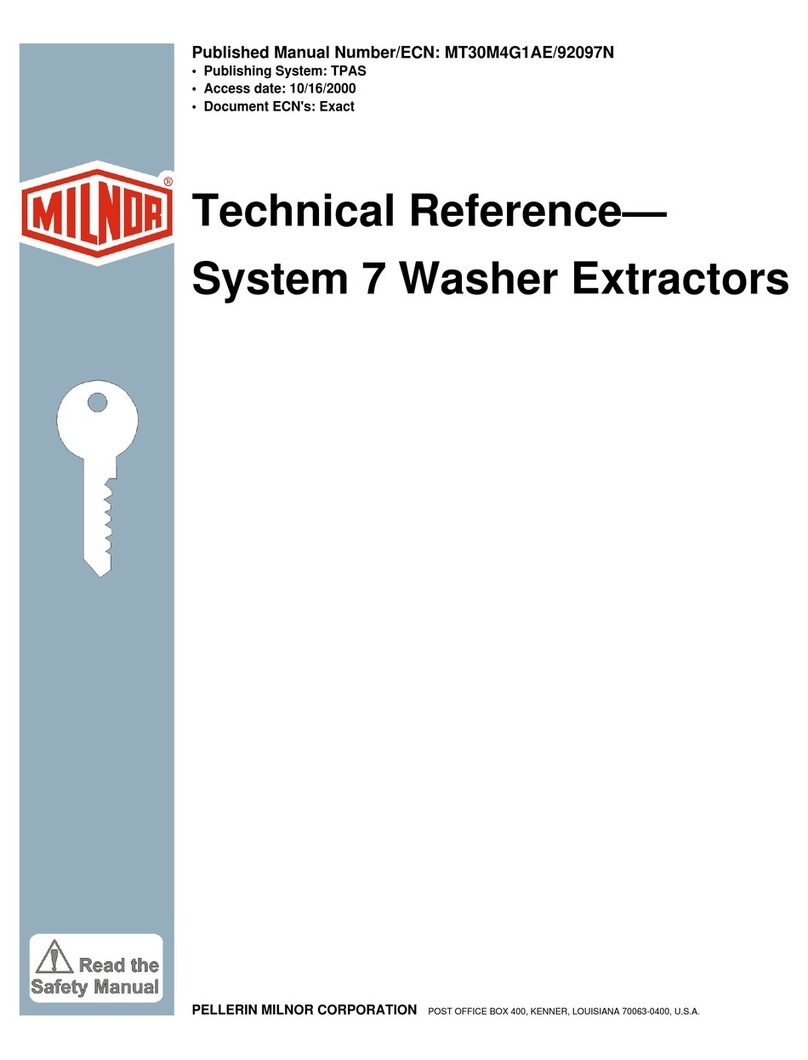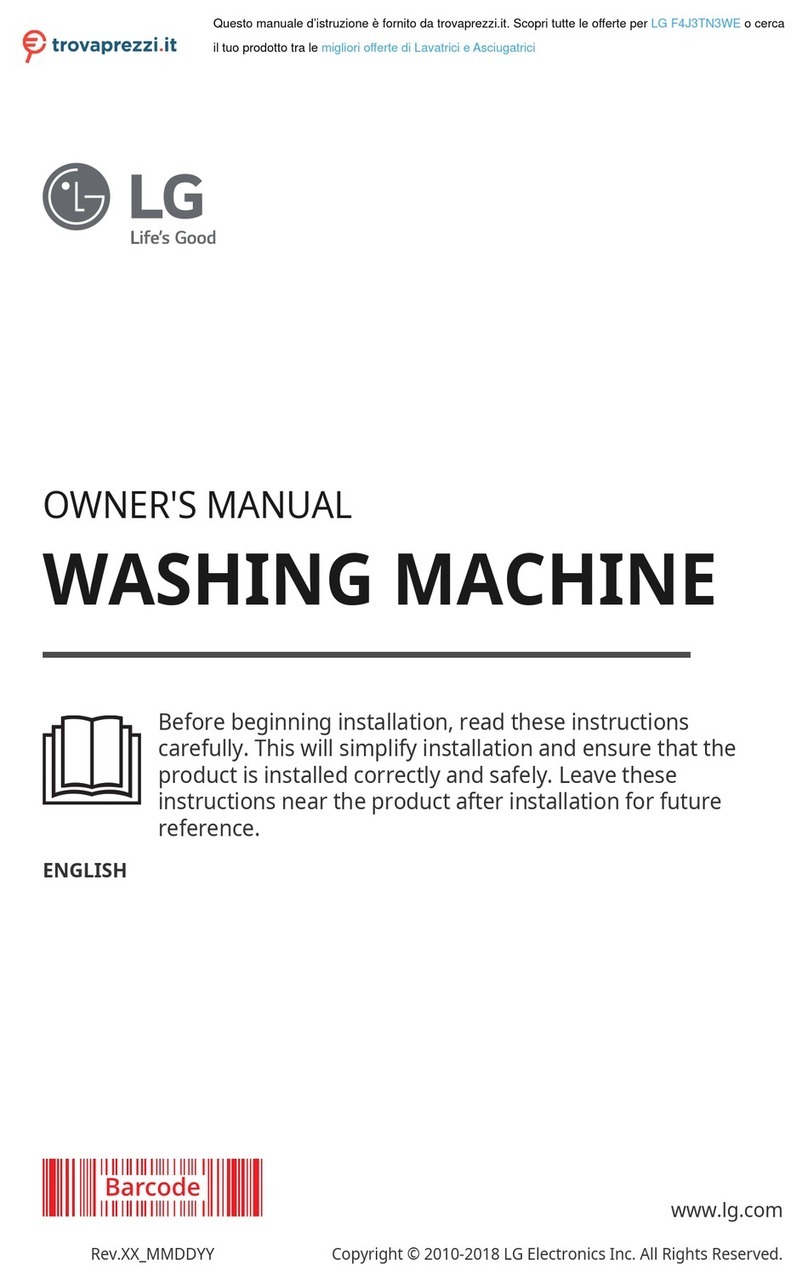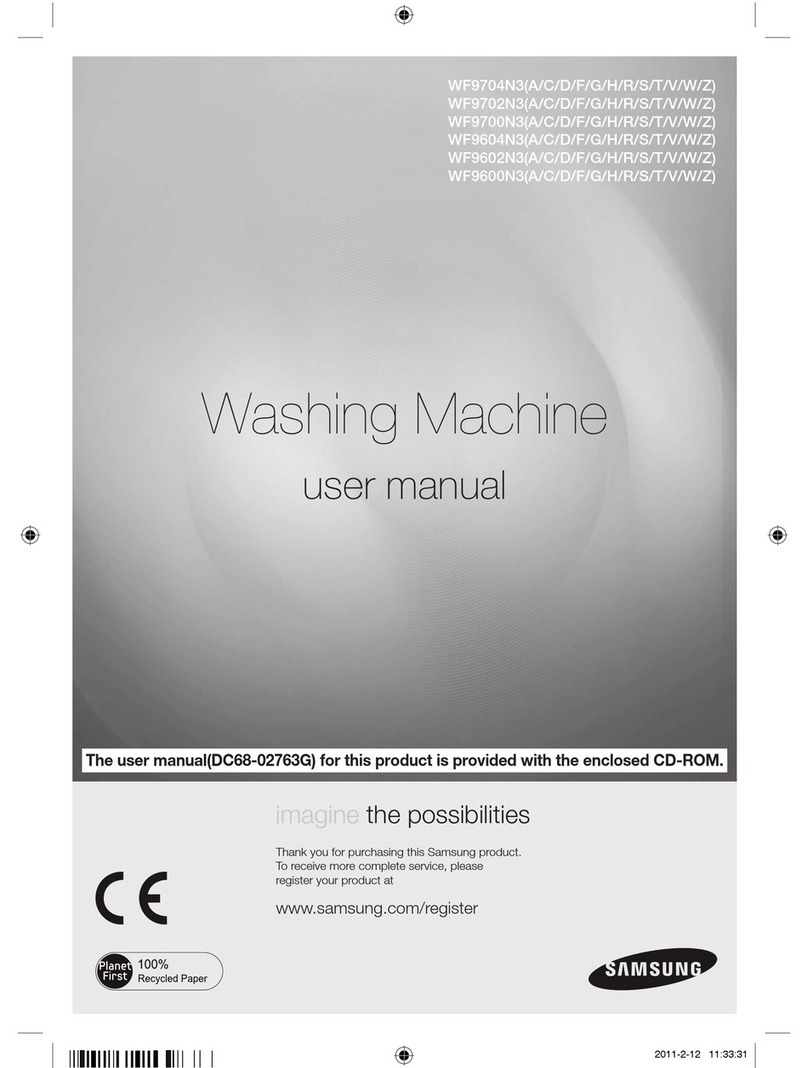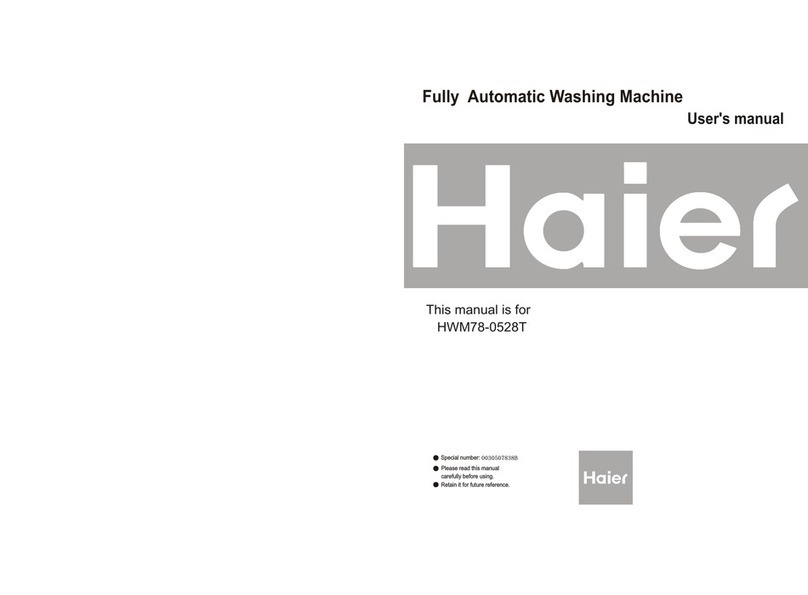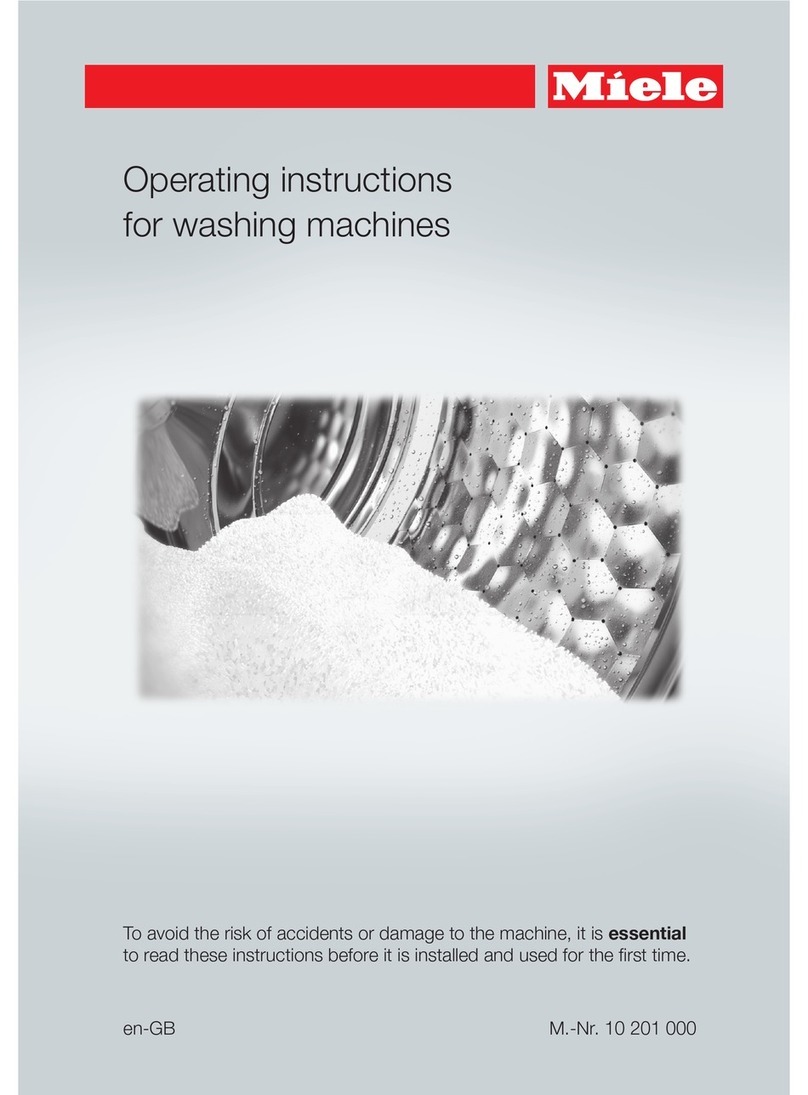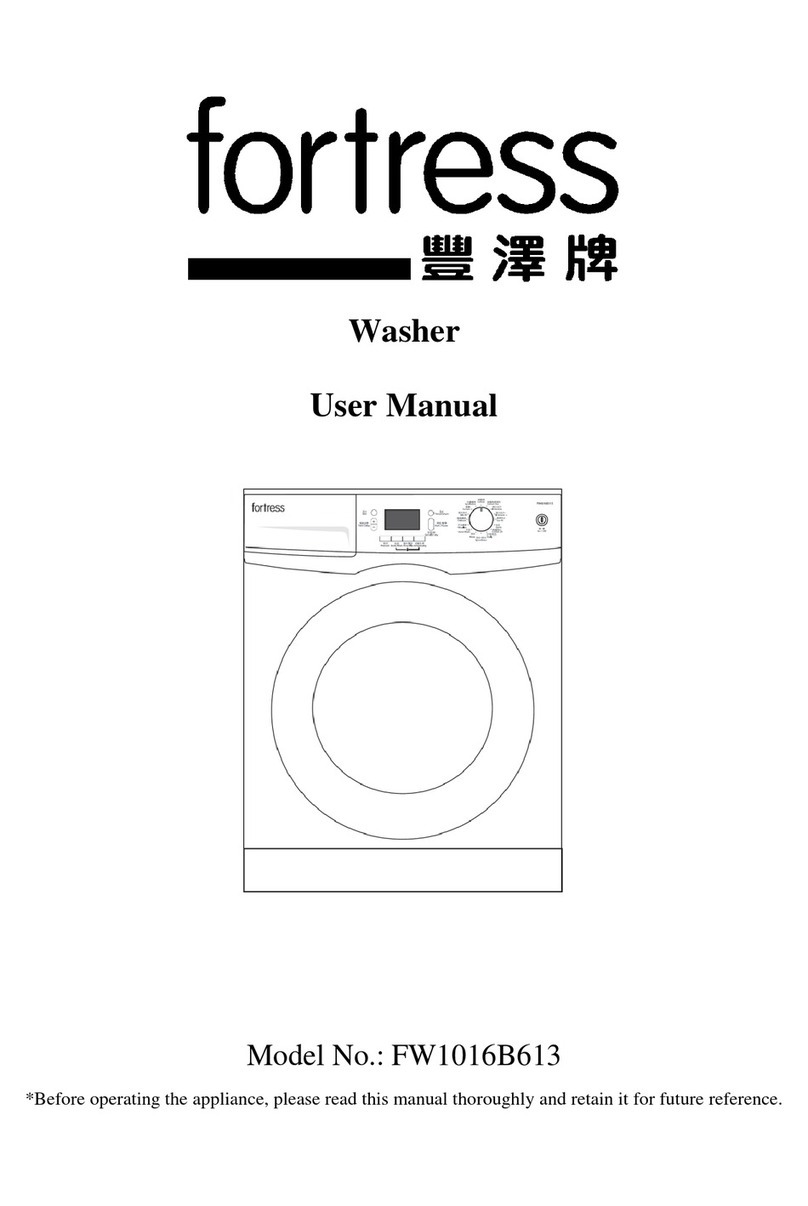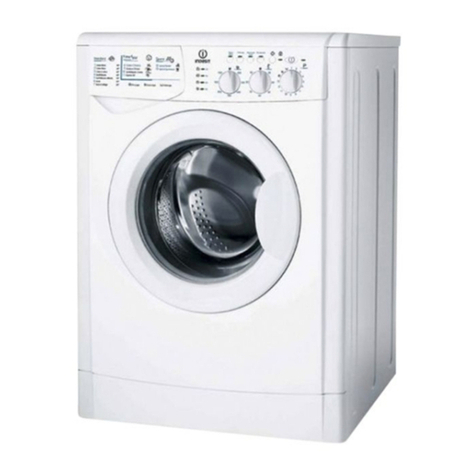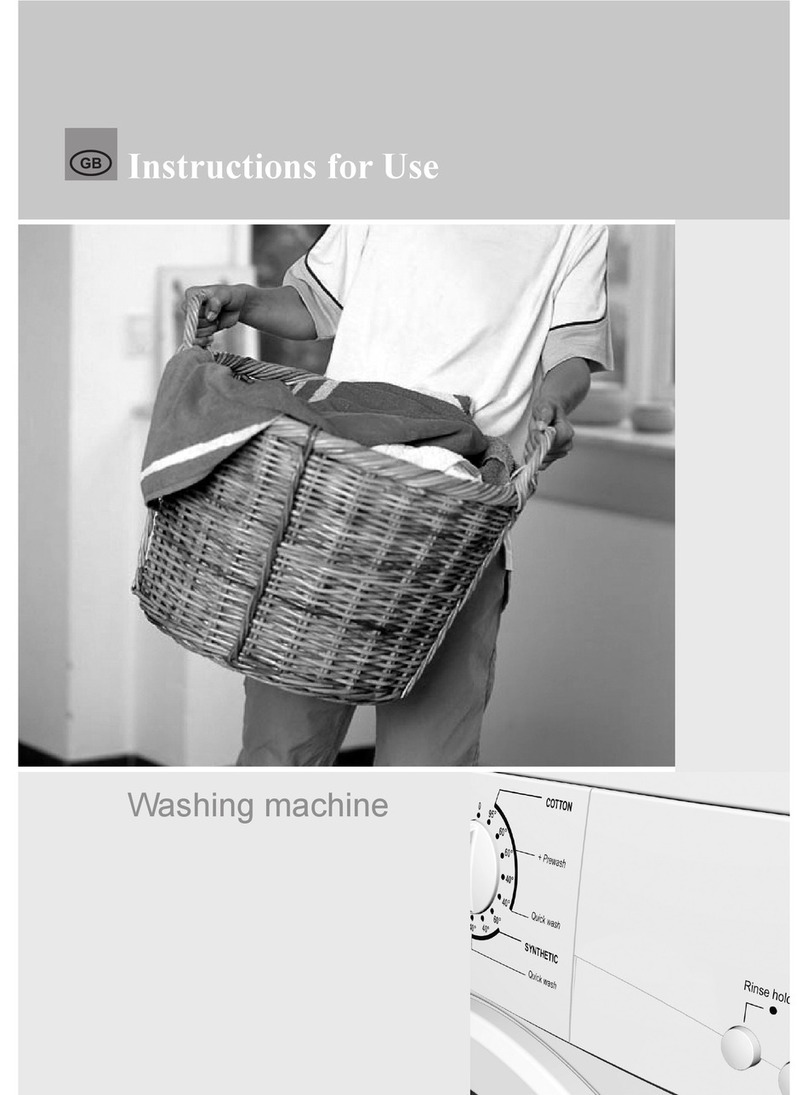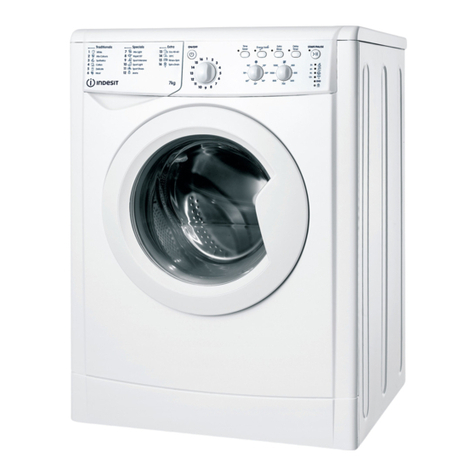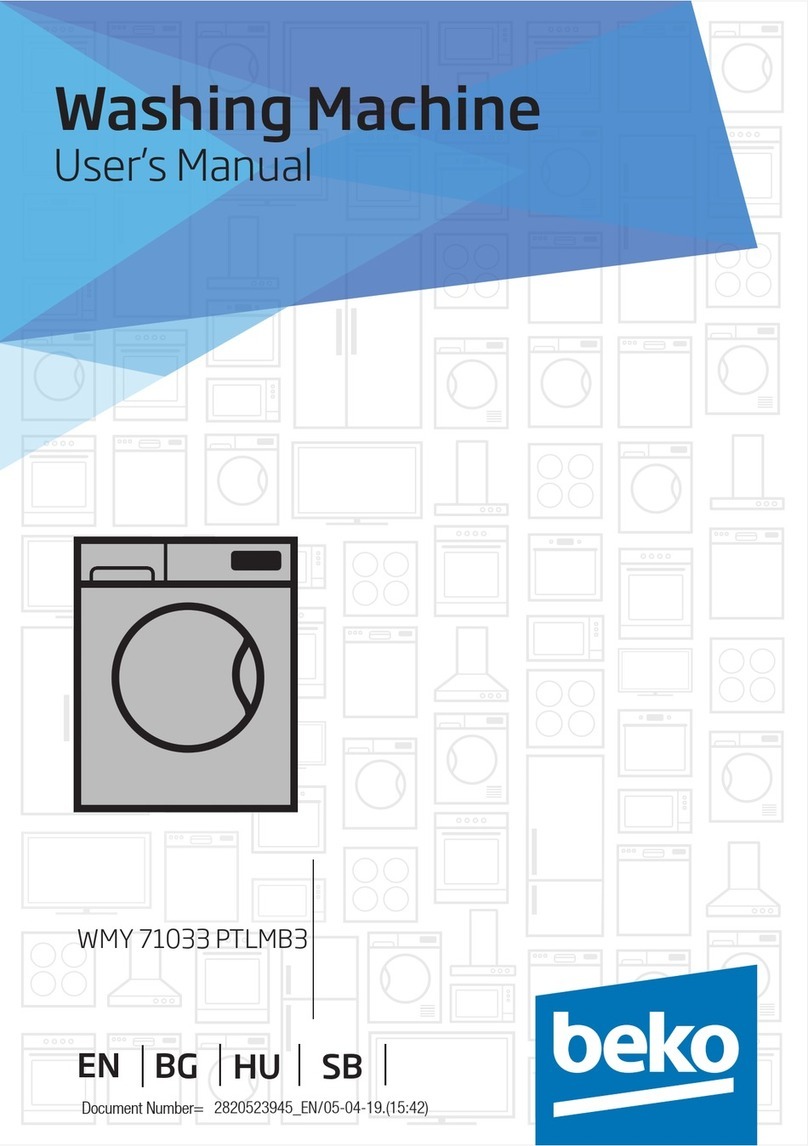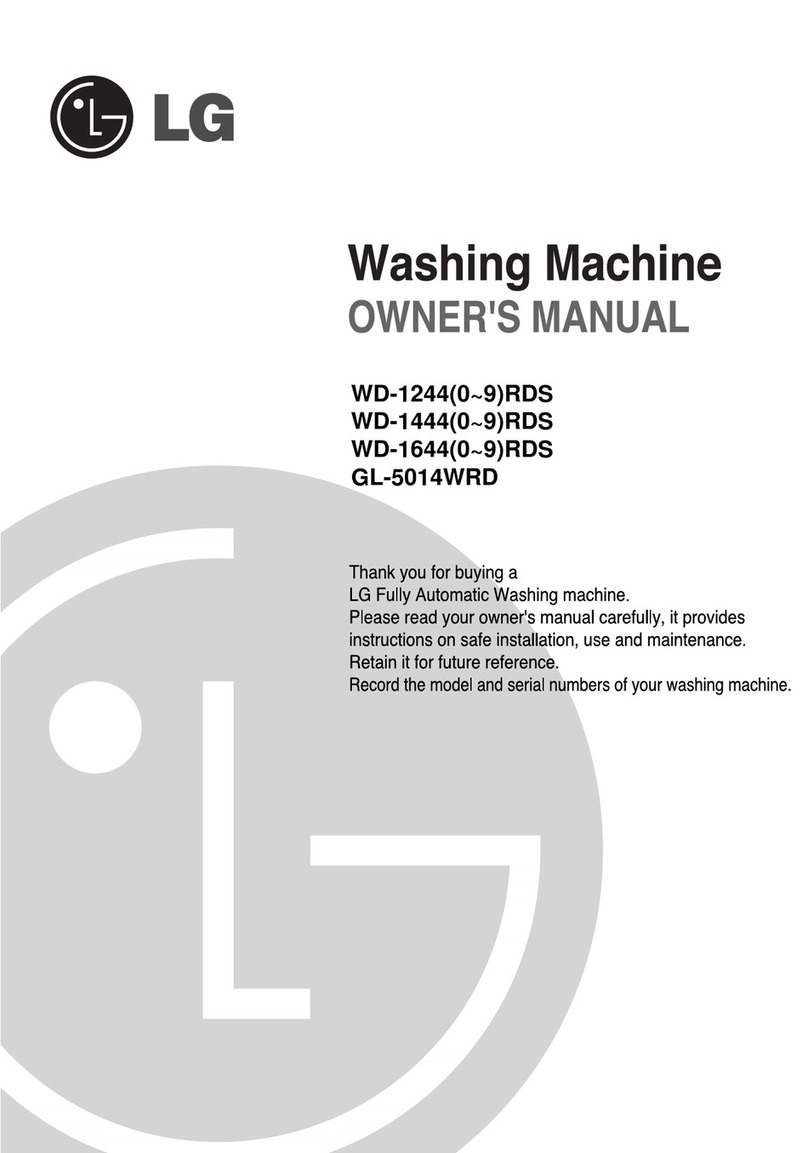Ignis AWF 591 User manual

CONTENTS
BEFORE USING THE WASHING
MACHINE
PRECAUTIONS AND GENERAL
RECOMMENDATIONS
DESCRIPTION OF THE WASHING
MACHINE
DOOR
BEFORE THE FIRST WASH CYCLE
PREPARING TO WASH
DETERGENT AND ADDITIVES
REMOVING THE FILTER
DRAINING RESIDUAL WATER
CARE AND MAINTENANCE
TROUBLESHOOTING GUIDE
AFTER SALES SERVICE
ACCESSORIES
TRANSPORT / HANDLING
ELECTRICAL CONNECTION
50110087GB.fm Page 18 Thursday, March 2, 2006 4:37 PM
Black process 45.0° 100.0 LPI

19
BEFORE USING THE WASHING MACHINE
1.Removing the packaging and checking
•After unpacking, make sure that the washing
machineisundamaged.Ifindoubt,donotusethe
washing machine. Contact After-SalesService or
your local retailer
•Checkthattheaccessoriesandsuppliedpartsare
all present
•Keep the packaging materials (plastic bags,
polystyrene parts, etc.) out of the reach of
children; they can constitute a possible source of
danger.
•If the appliance was exposed to the cold prior to
delivery, keep it at room temperature for a few
hours before operating.
2.Remove the transport bolts
•The washing machine is fitted with a transport
boltstoavoidany possibledamagetotheinterior
during transport.
Before using the washing machine, it is
imperative that the transport bolts are removed
3.Install the washing machine
•Remove the protective foil from the control
panel
•Move the appliance without lifting it by the
worktop
•Install the appliance on a solid and level floor
surface. In the case of a yielding sub-floor the
machine should be installed in a corner of the
room.
•Make sure that all four feet are resting firmly on
thefloorandcheckthat theappliance isperfectly
level (use a spirit level)
•n case of wooden or so-called “floating floors”
(for instance certain parquet or laminate floors),
place the appliance on a 60 x 60 cm sheet of
plywood at least 3 cm in thickness which is
secured to the floor.
4.Water inlet
•Connect the water supply inlet hose in
accordance with regulations of your local water
company
•Water inlet: Cold water only
•Tap: 3/4” threaded hose connection
•Water Pressure
(flow pressure): 100-1000 kPa (1-10 bar).
5.Drain hose
•Connect the drain hose to the ventilated siphon
orhookit overtheedgeofa sinkbymeans ofthe
“U” bend.
6.Electrical connections
•Electrical connections must be carried out by a
qualified technician in compliance with the
manufacturer’s instructions and local safety
regulations
•Data concerning voltage, consumption and fuses
are located on the inside of the appliance door
•The appliance must be connected to the mains
exclusively by means of a socket with an earth
connection in accordance with established
regulations.
The washing machine must be earthed by law.
The manufacturer declines all responsibility for
injury to persons or pets, or damage to property
caused by non-compliance with the above-
mentioned regulations
•Do not use extension leads or multi sockets
•Before any maintenance work on the washing
machine disconnect it from the mains or turn off
the power supply
•Access to the mains plug or to disconnection
from mains supply via a double-pole switch must
be ensured at all times following the installation
•Do not operate the washing machine if it has
been damaged during transport. Inform the
After-Sales Service
•Mainscablereplacementisonly tobecarriedout
by After-Sales Service
•The washing machine must only be used in the
household for the prescribed uses
Minimum housing dimensions:
Width: 600 mm
Height: 825 mm
Depth: 600 mm
50110087GB.fm Page 19 Thursday, March 2, 2006 4:37 PM
Black process 45.0° 100.0 LPI

20
PRECAUTIONS AND GENERAL
RECOMMENDATIONS
1.Packaging
•The packaging is 100% recyclable and is marked
with the recycling symbol. Adhere to
current local regulations when disposing of
packaging material
2.Disposing of packaging and scrapping
old washing machines
•The washing machine is built from reusable
materials. It must be disposed of in compliance
with current local waste disposal regulations.
•Before scrapping, remove all detergent residues
and cut off the power cable so that the washing
machine is made unusable.
•This appliance is marked according to the
European directive 2002/96/EC on Waste
Electrical and Electronic Equipment (WEEE).
By ensuring this product is disposed of correctly,
you will help prevent potential negative
consequences for the environment and human
health, which could otherwise be caused by
inappropriate waste handling of this product.
The symbol on the product, or on the
documents accompanying the product, indicates
that this appliance may not be treated as
household waste. Instead it shall be handed over
totheapplicablecollectionpointfortherecycling
of electrical and electronic equipment.
Disposal must be carried out in accordance with
localenvironmentalregulationsfor waste disposal.
For more detailed information about treatment,
recovery and recycling of this product, please
contact your local city office, your household
waste disposal service or the shop where you
purchased the product.
3.Location and surroundings
•The washing machine must only be installed in
closed spaces.
•Do not store flammable fluids near the appliance.
4.General recommendations
•Never leave the washing machine connected
unnecessarily
•Turn off the tap
•Before any cleaning and maintenance work pull
outthemainsplugorswitchoffthepowersupply
•Clean the outside of the washing machine with a
damp cloth. Do not use abrasive detergents
•Never open the door forcibly or use it as a step
•The appliance must not be operated by children.
Children must not be allowed to play with the
washing machine or to climb into the drum.
•If necessary, the power cable may be replaced
with an identical one obtained from our After-
Sales Service.
The power cable must only be replaced by a
qualified technician
5.EC Declaration of Conformity
•This appliance complies with the EC Directives:
73/23/EEC Low Voltage Directive
89/336/EEC EMC Directive
93/68/EEC CE Marking Directive
50110087GB.fm Page 20 Thursday, March 2, 2006 4:37 PM
Black process 45.0° 100.0 LPI

21
DESCRIPTION OF THE WASHING MACHINE
DOOR
BEFORE THE FIRST WASH CYCLE
1. Intermediate cover panel
2. Control panel
3. Detergent dispenser
4. After-SalesServicesticker(inside
door)
5. Door
6. Filter
7. Residual water drain hose
8. Adjustable feet.
Open the door when the “Door open” indicator lamp is on. Pull the
handle gently to open the door. Close the door with light force,it will lock
home audibly.
To remove any residual water used in testing by the manufacturer, we recommend that you carry out a
short wash cycle without laundry.
1. Turn on the tap.
2. Close the door.
3. Pour a little detergent (about 30ml) into the detergent compartment .
4. Select and start a short programme (see quick reference guide).
1
2
4
5
7
6
3
8
50110087GB.fm Page 21 Thursday, March 2, 2006 4:37 PM
Black process 45.0° 100.0 LPI

22
PREPARING TO WASH
1.Sort the laundry according to...
•Type of fabric / care label symbol
Cottons, mixed fibres, easy care/synthetics,
wool, handwashed items
•Colours
Separate coloured and white items. Wash new
coloured articles separately
•Size
Laundry items of different sizes distribute
themselves better in the drum and optimize the
washing and spinning action
•Delicates
Washsmallitems(e.g.nylonstockings,belts etc.)
and items with hooks (e.g. bras) in a washbag or
a pillowcase with a zip-fastener. Either remove
curtain glidesor tie them up in a cloth bag
2.Empty all pockets
Coins, safety pins etc. can damage laundry,
drums and tubs
3.Closures
Closezips and hooksand eyes; Tieloose belts or
straps together
Stain removal
•Blood, milk, egg etc. are generally removed by
the automatic enzyme phase of the programme
•To remove red wine, coffee, tea, grass and fruit
stains etc. add stain remover to the detergent
dispenser chamber
•Pre-treatheavily-soiledareas with stainremover
if necessary
Dyeing
•Only use dyes that are suitable for washing
machines
•Follow the manufacturer’s instructions.
•Plastic and rubber parts of the washing machine
can become discoloured
Loading the laundry
1.Open the door.
2.Unfold the laundry and place it loosely in the
drum. Observe the load sizes given in the Quick
Reference Guide.
Note: Overloading the machine will result in
unsatisfactory washing results and creased
laundry.
3.Close the door.
50110087GB.fm Page 22 Thursday, March 2, 2006 4:37 PM
Black process 45.0° 100.0 LPI

23
DETERGENT AND ADDITIVES
The choice of detergent depends on:
•type of fabric (cottons, easy care/synthetics,
delicate items, wool).
Note: Use only specific detergents for washing
wool
•colour
•the wash temperature
•degree and type of soiling
Remarks:
Whitish residues on dark fabrics are caused by
insoluble water softeners used in modern
phosphate-freepowderdetergents.Shakeorbrush
out the item concerned or use liquid detergents.
Use only detergents and additives specifically
produced for domestic washing machines.
When using descaling agents, bleaches or dyes for
the pre-wash, make sure that they are suitable for
washing machines. Descaler could contain
substances which can attack parts of your washing
machine.
Do not use any solvents
(e.g. turpentine, benzine). Do not wash fabrics in
themachine whichhavebeentreatedwithsolvents
or flammable liquids.
Dosage
Follow the dosage recommendations on the
detergent pack. They depend on:
•degree and type of soiling
•size of wash
full load: follow the detergent manufacturer’s
instructions;
half load: 3/4 the amount used for a full load;
Minimum load (about 1 kg):
1/2 the amount used for a full load
•Water hardness in your area (request
information from the water company). Soft
water requires less detergent than hard water
(refer to water hardness table)
Notes:
Too much detergent can result in excess foam
formation.
The cleaning effect deteriorates.
If the washing machine detects too much foam, it
may prevent spinning.
Insufficient detergent may result in grey laundry in
timeandalsocalcifiestheheatingsystem,drumand
hoses.
Water Hardness Chart
WATERHARDNESS
RANGE CHARACTERISTICS GERMAN
°dH FRENCH
°fH ENGLISH
°eH
1
2
3
4
soft
medium
hard
very hard
0-7
7-14
14-21
over 21
0-12
12-25
25-37
over 37
0-9
9-17
17-26
over 26
50110087GB.fm Page 23 Thursday, March 2, 2006 4:37 PM
Black process 45.0° 100.0 LPI

24
Pouring in detergents and additives
Chamber
•Detergent for the prewash
Chamber
•Detergent for the main wash
•Stain remover
•Water softener (water hardness 4)
When using liquid detergent, remove the coloured insert from the
detergent dispenser and insert it in the first slot in chamber.
The scale on the insert makes dosing easier.
Chamber
•Fabric Softener
•Liquid starch
Only pour additives in up to the “Max” mark.
Notes:
•Keep detergents and additives in a safe, dry place out of the reach of children.
•Liquid detergents can be used for programmes with prewash. In this case only measure in a powder
detergent for the main wash.
•Only use powder detergent when using the Start Delay. The powder detergent stays in the detergent
dispenser until the programme start, but liquid detergent may run out of the detergent dispenser.
•To prevent dispensing problems when using highly concentrated powder and liquid detergents, use
the commercially available detergent ball or bag and measure out directly into the drum.
Measure out gel-type detergent like powder detergent.
•Whenusingdescaling agents, bleaches ordyes,make sure that theyaresuitable for washingmachines.
Descalers could contain components that can attack parts of your washing machine.
•Do not use any solvents in the washing machine (e. g. turpentine, benzine).
•If you use starch powder, proceed as follows:
1. Wash your laundry using the desired wash programme.
2. Then stir the starch in with water in a beaker.
3. Select the “Rinse and Spin” programme, reduce the speed to 800 rpm and start the programme.
4. Pull out the detergent drawer until you can see about 3 cm. of chamber.
5. Pour the starch solution into chamber while the water is running into the detergent dispenser .
6. If there are starch residues in the detergent dispenser when the programme has finished, clean it if
necessary (see “Cleaning and Maintenance”).
Take note also of the starch manufacturer’s information.
50110087GB.fm Page 24 Thursday, March 2, 2006 4:37 PM
Black process 45.0° 100.0 LPI

25
REMOVING THE FILTER
We recommend that you check and clean the filter
regularly, at least two or three times a year.
Especially:
•When the appliance does not drain or spin properly
•If the pump is blocked by a foreign body (e.g. buttons,
coins or safety pins).
IMPORTANT: Make sure the washing water has
had time to cool before draining the appliance.
1. Switch off the appliance and unplug it.
2. Remove the plinth.
3. Place a container beneath it.
4. Open the filter but do not withdraw it completely.
Slowly turn the handle anticlockwise until the water
drains out.
5. Wait until all the water has drained off.
6. Now unscrew the filter completely and remove it.
7. Clean the filter and the filter chamber.
8. Check that the pump rotor still moves freely.
9. Insertthe filterwith theguidepinupwardsandscrewit
in clockwise to the stop (handle horizontal).
10.Pour about 1 litre of water into the detergent drawer
to reactivate the Eco system. Check that the filter is
seated properly and tightly in place.
11.Fit the plinth again.
12.Reinsert the plug in the socket.
13.Select a programme and start it.
50110087GB.fm Page 25 Thursday, March 2, 2006 4:37 PM
Black process 45.0° 100.0 LPI

26
DRAINING RESIDUAL WATER
CARE AND MAINTENANCE
Appliance exterior and control panel
•Can be washed down with a soft, damp cloth
•A little neutral cleaner (not abrasive) can be used
if necessary
•Dry with a soft cloth
Door seal
•Rub down occasionally with a damp cloth
•Regularly check the seal folds for foreign bodies
Filter
•We recommend that you check and clean the
filter regularly, at least two or three times a year
or (see “Removing the Filter”)
When should the residual water be removed?
•To transport the machine (relocation)
•In a frost-endangered room. In this case, it is
recommended that the machine be emptied after each
wash cycle.
Before emptying the residual water, switch the
appliance off and unplug it from the mains socket.
The residual water drain hose is located behind the
plinth.
1. Remove the plinth cover.
2. Grasp the cap and pull out together with the hose.
Place a low container beneath it. Pull off cap from end
of hose.
3. Drain the water into a low container until no more
water flows out. Then close the residual water drain
hose and insert it again.
Before using the washing machine again:
1. Pourapprox.1litreof waterintothe detergentdrawer
to reactivate the Eco system.
2. Reinsert the plug in the socket.
50110087GB.fm Page 26 Thursday, March 2, 2006 4:37 PM
Black process 45.0° 100.0 LPI

27
Detergent dispenser
1. Press the release lever in the prewash compartment downward
and remove the drawer.
2. Remove the inserts (the siphon from the softener compartment
and the coloured insert for liquid detergent).
3. Wash under running water.
4. Replace the siphon and the liquid detergent insert. Insert the
detergent dispenser in the washing machine.
Water hose mesh filter
Check and clean regularly.
Check the supply hose regularly for brittleness and cracks and
replace with a new hose of the same type (obtainable from After-
SalesServiceoryourdealer).Isolate theapplianceimmediatelyfrom
the mains if the hose is damaged
1. Turn off the tap and unscrew the water inlet hose from the tap.
2. Cleantheinternalmeshfilterandscrewthewaterinlethoseback
onto the tap.
3. Now unscrew the inlet hose on the rear of the washing machine.
4. Clean the mesh filter and screw the water inlet hose back on.
5. Turn on the tap and ensure that the connections are completely
water-tight.
50110087GB.fm Page 27 Thursday, March 2, 2006 4:37 PM
Black process 45.0° 100.0 LPI

28
TROUBLESHOOTING GUIDE
Depending on the model, your washing machine is
equipped with various automatic safety functions.
This enables faults to be detected in good time and
the safety system can react appropriately. These
faults are frequently so minor that they can be
removed within a few minutes.
The appliance will not start, no lamp
lights up.
Check whether:
•the mains plug is inserted into the socket
•the wall socket is functioning correctly (use a
table lamp or similar) to test
the washing machine will not start...
(varies according to model)... and the
“Start/Pause” light flashes
Check whether:
•the appliance door is properly closed;
•The “Start/Pause” button has been pressed
...and the “Start/Pause” light goes on
(for models with a digital display a dash appears here).
Check whether:
•a programme has been selected
...and the “On/Off” lamp goes on.
Check whether:
•The appliance door is properly closed;
•the tap is turned on (see also “Fault in the water
supply/safety hose”)
•a programme has been selected
The washing machine stops during the
programme
(varies depending on model).
Check whether:
•The “Rinse Hold” light flashes, or the “Rinse
Hold” button has been pressed; terminate this
special option by pressing the button
•Another programme has been selected and the
“Start/Pause” button is flashing. Reselect the
desired programme and press the “Start/Pause”
button
•Thedoorhasbeenopenedandthe “Start/Pause”
light is flashing. Close the door and press the
“Start/Pause” button again
•The “On/Off” button has been pressed and the
light is on
•The washing machine safety system has been
activated (see “Fault Indicators” table)
Detergent and additive product residues
in dispenser at end of wash.
Check whether:
•the siphon is correctly installed and clean (see
“Care and Maintenance”)
•sufficient water is entering. The mesh filters in
the water connection could be blocked (see
“Care and Maintenance”)
•When using powder detergent beforehand the
coloured insert for dosing liquid detergent has
been removed from the dispenser
The washing machine vibrates during the
spin cycle.
Check whether:
•The washing machine is level and standing firmly
on all four feet
•The transport bolts have been removed. Before
using the washing machine, it is imperative that
the transport bolts are removed
Final spin results are poor.
The washing machine has an unbalance detection
and correction system. If individual heavy items are
loaded (a bathmat, bathrobe), this system may
reduce the spin speed automatically or even
interrupt the spin completely if it detects too great
animbalanceeven after several spinstarts, in order
to protect the washing machine.
•If the laundry is still too wet at the end of the
cycle,addotherarticlesoflaundryandrepeatthe
spin cycle
•Excessive foam formation may prevent spinning.
Observe correct detergent dosages
•Check whether spin speed “0” was selected
Fault display table
Luminous display Spin speed
lights Digital display
(if fitted) Fault description
“Tap off” flash “H” and “F” “Fault in water supply”
- flash “P” and “F” “Draining fault”
- flash from “F4” to “F16” “Fault in an electrical component”
“Water Stop” flash “A” and “F” “Water Stop fault”
50110087GB.fm Page 28 Thursday, March 2, 2006 4:37 PM
Black process 45.0° 100.0 LPI

29
a. Fault in the water supply
The appliance has no or insufficient water supply.
For models with a fault display, the “Tap Off” display
lights up and the spin speed indication lights flash. If a
digital display is fitted, “H” and “F” are also displayed
alternately.
For models with no fault display, the washing machine
stops in the appropriate programme step.
Switch the appliance off and pull out the mains plug.
Check whether:
•the water tap is fully turned on, and the water
supply pressure is sufficient
•the water inlet hose is kinked
•the water connection mesh filters are blocked (see
“Care and Maintenance/Filters in water inlet
hoses”)
•the water supply hose is frozen up
•thewashingmachinehasasafetyhoseandthesafety
valve is open (red indicator in the safety valve
inspection window); In this case replace it with a
new safety hose
Reconnect the appliance to the electrical socket.
For models with a fault display, reselect the desired
programme and start it.
For models without a fault display continue the
programme by pressing the “On/Off” button again.
If the fault occurs again, please contact After Sales
Service (see “After Sales Service”).
b.Draining fault
Waste water not pumped out.
For models with a fault display, the spin speed
indication lights flash. If a digital display is fitted, “P”
and “F” are also displayed alternately.
For models with no fault display, the washing machine
stops in the appropriate programme step.
Switch the appliance off and pull out the mains plug.
Check whether:
•the drain hose is kinked
•The pump or the filter is blocked (see “Removing
the Filter”)
IMPORTANT: Before draining, make sure that the
washing water has cooled down.
•The water in the drain hose is frozen
Reconnect the appliance to the electrical socket.
For models with fault display, select and start the
“Drain/Cancel” programme.
To rinse the laundry, we then recommend a short
programme without the addition of detergent.
For models without a fault display continue the
programme by pressing the “On/Off” button again.
If the fault occurs again, please contact After Sales
Service (see “After Sales Service”).
c. Fault in an electrical component
The appliance stops in the middle of a programme.
For models with a fault display, the spin speed
indicationlightsflash.Ifadigitaldisplayisfitted,“F4”to
“F16” are also displayed.
Switch the washing machine off. First of all select and
start the “Drain/Cancel” programme.
Then select and start the desired programme again.
For models with no fault display, the washing machine
stops in the appropriate programme step.
First switch the washing machine off and on again to
continue with the programme.
If the fault persists, please contact After Sales Service
(see “After Sales Service”).
d.“Water Stop” fault (if fitted)
The “Water Stop” fault may have been triggered by:
1. excess foaming.
2. A leak in the washing machine.
In this case the pump is switched on automatically in
order to pump the water out.
For models with a fault display, the “Water Stop”
indicator lights up and the spin speed indicator lights
flash. If a digital display is fitted, “A” and “F” are also
displayed alternately.
For models with no fault display, the washing machine
stops in the appropriate programme step.
Switch the appliance off, pull out the mains plug and
turn the water tap off.
Tilt the appliance forwards carefully to allow the
collected water to flow out from the bottom of the
appliance.
Then:
1. Plug in the appliance.
2. Turn the water tap on (if water immediately flows
into the appliance again, without the appliance
being started, there is a fault. Turn off the tap and
notify After Sales Service).
3. For models with fault display, select and start the
desired programme again.
For models with no fault display, continue the
programmeby pressingthe “On/Off” buttonagain.
If the fault occurs again, please contact After Sales
Service (see “After Sales Service”).
“Water Stop” fault, when the programme
selector is in the “ ” position.
The pump is switched on automatically in order to
pump the water out.
Formodels withfault displaythe washingmachine will
also detect a Water Stop fault (leak) if the programme
selector is in the “ ” position. In this case the digital
display (if one exists) alternately shows “A” and “F”.
For models with no fault display, the “Water Stop”
fault is detected when the appliance is switched on
again.
Pull the mains plug out and ensure that the water tap
is turned off.
Tilt the appliance forwards carefully to allow the
collected water to flow out.
Then:
1. Plug in the appliance.
2. Turn the water tap on (if water immediately flows
into the appliance again, without the appliance
being started, there is a fault. Turn off the tap and
notify After Sales Service).
50110087GB.fm Page 29 Thursday, March 2, 2006 4:37 PM
Black process 45.0° 100.0 LPI

30
AFTER SALES SERVICE
Before contacting After Sales Service:
1.Try to remedy the problem yourself (see
“Troubleshooting Guide”)
2.Restart the programme to check whether the
problem has solved itself.
3.If the washing machine continues to function
incorrectly, call After Sales Service.
Specify:
•The nature of the problem
•The washing machine model
•The service code (number after the word
SERVICE)
The After Sales Service sticker is on the
inside of the door.
•Your full address
•Your telephone number and area code.
After Sales Service numbers and addresses can
be found in the guarantee booklet or contact the
dealer
ACCESSORIES
ViaourAfter-SalesServiceoryourspecialistdealer,
you can obtain:
•a Pedestal Drawer which can be installed
beneath your washing machine. It raises your
machine to allow for more comfortable loading
and unloading, as you now no longer need to
bend as far to access the unit. Furthermore, it
offers a great space-management tool and
storage solution.
•a Stacking Kit by means of which you can fix
your dryer on top of your washing machine and
thus effectively save space.
Some models are able to be installed under your
kitchen worktop; in that case, please contact our
After-Sales Service (see above). Be aware that:
•the appliance MUST be installed under a
continuous worktop.
•according to the legal safety regulations, the
installationof the applianceMUST be carriedout
byan authorized technicianor by ourAfter-Sales
Service.
•the appliance MUST be installed using the
intermediate cover panel of the UBS Base Set
which can be obtained from specialist dealers or
our After-Sales Service.
TRANSPORT / HANDLING
Never lift the appliance by the worktop when transporting.
1. Pull out the power plug.
2. Turn off the tap
3. Remove the water supply and drain hose from the domestic connection.
4. Drain residual water from the appliance and hoses
(see “Removing the Filter/ Draining Residual Water”)
5. Fit the transit bolts (obligatory).
50110087GB.fm Page 30 Thursday, March 2, 2006 4:37 PM
Black process 45.0° 100.0 LPI

31
ELECTRICAL CONNECTION
For Great Britain only
Warning - this appliance must be earthed
Fuse replacement
If the mains lead of this appliance is fitted with a
BS 1363A 13amp fused plug, to change a fuse in this type
of plug use an A.S.T.A. approved fuse to BS 1362 type and
proceed as follows:
1. Remove the fuse cover (A) and fuse (B).
2. Fit replacement 13A fuse into fuse cover.
3. Refit both into plug.
Important:
The fuse cover must be refitted when changing a fuse and
if the fuse cover is lost the plug must not be used until a
correct replacement is fitted.
Correct replacement are identified by the colour insert or
the colour embossed in words on the base of the plug.
Replacement fuse covers are available from your local
electrical store.
For the Republic of Ireland only
The information given in respect of Great Britain will
frequently apply, but a third type of plug and socket is also
used, the 2-pin, side earth type.
Socket outlet / plug
(valid for both countries)
If the fitted plug is not suitable for your socket outlet,
Please contact Whirlpool Service for further instruction.
Please do not attempt to change plug yourself. This
procedureneedstobecarriedoutbyaqualifiedWhirlpool
technician in compliance with the manufactures
instructions and current standard safety regulations.
50110087GB.fm Page 31 Thursday, March 2, 2006 4:37 PM
Black process 45.0° 100.0 LPI
Table of contents
Other Ignis Washer manuals
